Related Research Articles
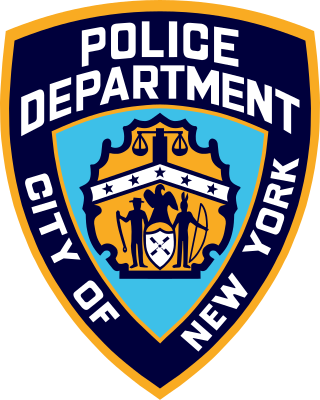
The New York City Police Department (NYPD), officially the City of New York Police Department, is the primary law enforcement agency within New York City. Established on May 23, 1845, the NYPD is the largest, and one of the oldest, municipal police departments in the United States.
The blue wall of silence, also blue code and blue shield, are terms used to denote the supposed informal code of silence among police officers in the United States not to report on a colleague's errors, misconducts, or crimes, especially as related to police brutality in the United States. If questioned about an incident of alleged misconduct involving another officer, while following the code, the officer being questioned would perjure themselves by feigning ignorance of another officer's wrongdoing.
Police misconduct is inappropriate conduct and illegal actions taken by police officers in connection with their official duties. Types of misconduct include among others: sexual offences, coerced false confession, intimidation, false arrest, false imprisonment, falsification of evidence, spoliation of evidence, police perjury, witness tampering, police brutality, police corruption, racial profiling, unwarranted surveillance, unwarranted searches, and unwarranted seizure of property.

As of 2020, more than 800,000 sworn law enforcement officers have been serving in the United States. About 137,000 of those officers work for federal law enforcement agencies.

The NYC Civilian Complaint Review Board (CCRB) is the civilian oversight agency of the New York City Police Department (NYPD), the largest police force in the United States. A board of the Government of New York City, the CCRB is tasked with investigating, mediating and prosecuting complaints of misconduct on the part of the NYPD. Its regulations are compiled in Title 38-A of the New York City Rules.

The New York Civil Liberties Union (NYCLU) is a civil rights organization in the United States. Founded in November 1951 as the New York affiliate of the American Civil Liberties Union, it is a not-for-profit, nonpartisan organization with nearly 50,000 members across New York State.
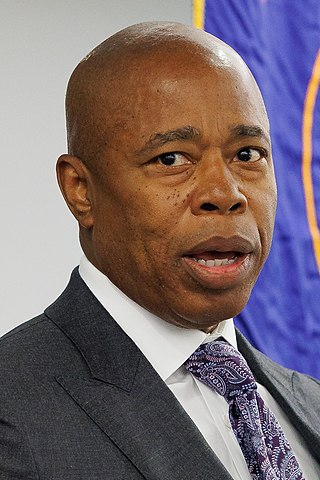
Eric Leroy Adams is an American politician and former police officer, serving as the 110th mayor of New York City since 2022. Adams was an officer in the New York City Transit Police and then the New York City Police Department for more than 20 years, retiring at the rank of captain. He served in the New York State Senate from 2006 to 2013, representing the 20th Senate district in Brooklyn. In November 2013, Adams was elected Brooklyn Borough President, the first African-American to hold the position, and reelected in November 2017.
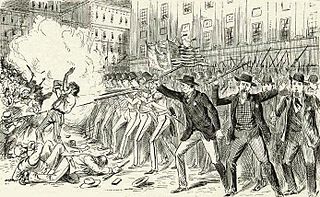
The New York City Police Department (NYPD) originates in the Government of New York City attempts to control rising crime in early- to mid-19th-century New York City. This increased crime was due to an increased population, caused primarily by poor Irish immigrants beginning in the 1820s. The City's reforms created a full-time professional police force modeled upon London's Metropolitan Police, itself only formed in 1829. Established in 1845, the Municipal Police replaced the inadequate night watch system which had been in place since the 17th century, when the city was founded by the Dutch as New Amsterdam.

Throughout the history of the New York City Police Department, numerous instances of corruption, misconduct, and other allegations of such, have occurred. Over 12,000 cases have resulted in lawsuit settlements totaling over $400 million during a five-year period ending in 2014. In 2019, taxpayers funded $68,688,423 as the cost of misconduct lawsuits, a 76 percent increase over the previous year, including about $10 million paid out to two exonerated individuals who had been falsely convicted and imprisoned.
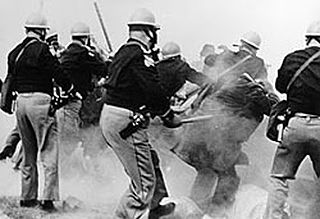
Police brutality is the repression by personnel affiliated with law enforcement when dealing with suspects and civilians. The term is also applied to abuses by "corrections" personnel in municipal, state, and federal prison camps, including military prisons.
Adrian Schoolcraft is a former New York City Police Department (NYPD) officer who secretly recorded police conversations from 2008 to 2009. He brought these tapes to NYPD investigators in October 2009 as evidence of corruption and wrongdoing within the department. The tapes were used as evidence of arrest quotas leading to police abuses such as wrongful arrests, and that emphasis on fighting crime sometimes resulted in under-reporting of crimes to artificially deflate CompStat numbers.
The stop-question-and-frisk program, or stop-and-frisk, in New York City, is a New York City Police Department (NYPD) practice of temporarily detaining, questioning, and at times searching civilians and suspects on the street for weapons and other contraband. This is what is known in other places in the United States as the Terry stop. The rules for the policy are contained in the state's criminal procedure law section 140.50 and based on the decision of the US Supreme Court in the case of Terry v. Ohio.

Floyd, et al. v. City of New York, et al., 959 F. Supp. 2d 540, is a set of cases addressing the class action lawsuit filed against the City of New York, Police Commissioner Raymond Kelly, Mayor Michael Bloomberg, and named and unnamed New York City police officers ("Defendants"), alleging that defendants have implemented and sanctioned a policy, practice, and/or custom of unconstitutional stops and frisks by the New York Police Department ("NYPD") on the basis of race and/or national origin, in violation of Section 1983 of title forty-two of the United States Code, the Fourth and Fourteenth Amendments to the United States Constitution, Title VI of the Civil Rights Act of 1964, and the Constitution and laws of the State of New York.
Racial profiling by law enforcement at the local, state, and federal levels, leads to discrimination against people in the African American, Native American, Asian, Pacific Islander, Latino, Arab, and Muslim communities of the United States. Examples of racial profiling are the use of race to determine which drivers to stop for minor traffic violations, or the use of race to determine which pedestrians to search for illegal contraband. Besides such disproportionate searching of African Americans and members of other minority groups, other examples of racial profiling by law enforcement in the U.S. include the Trump-era China Initiative following racial profiling against Chinese American scientists; the targeting of Hispanic and Latino Americans in the investigation of illegal immigration; and the focus on Middle Eastern and South Asians present in the country in screenings for ties to Islamic terrorism. These suspicions may be held on the basis of belief that members of a target racial group commit crimes at a higher rate than that of other racial groups.

The New York Police Department's Strategic Response Group (SRG) is a unit of the New York City Police Department (NYPD) formed in 2015 for counter-terrorism and the policing of political protests. They maintain a bike squadron and are outfitted with anti-riot gear, rifles, and body armor. The unit has been criticized for its use of excessive force and mass arrests against political demonstrators protected under the First Amendment, disproportionately high numbers of complaints to the Civilian Complaint Review Board, and the killing of unarmed men, among other things. Activists, the New York City Council, the New York City Department of Investigation, and organizations such as Human Rights Watch and the New York Civil Liberties Union, among others, have called for its regulation or disbandment.

The New York City Police Department (NYPD) actively monitors public activity in New York City, New York, United States. Historically, surveillance has been used by the NYPD for a range of purposes, including against crime, counter-terrorism, and also for nefarious or controversial subjects such as monitoring political demonstrations, activities, and protests, and even entire ethnic and religious groups.

Dermot Francis Shea is an American police officer who was the 44th New York City Police Commissioner. He assumed the position on December 1, 2019, and was sworn in by Mayor Bill de Blasio in a public ceremony on December 2.
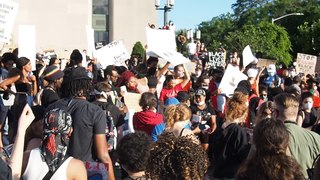
George Floyd protests in New York City took place at several sites in each of the five New York City boroughs, starting on May 28, 2020, in reaction to the murder of George Floyd. Most of the protests were peaceful, while some sites experienced protester and/or police violence, including several high-profile incidents of excessive force. Looting became a parallel issue, especially in Manhattan. As a result, and amid the COVID-19 pandemic, the city was placed under curfew from June 1–7, the first curfew in the city since 1943. The protests catalyzed efforts at police reform, leading to the criminalization of chokeholds during arrests, the repeal of 50-a, and other legislation. Several murals and memorials have been created around the city in George Floyd's honor, and demonstrations against racial violence and police brutality continued as part of the larger Black Lives Matter movement in New York City.
New York Civil Rights Law § 50-a was a section of the New York Civil Rights Law, enacted in 1976, which required the concealment of disciplinary records of police officers, firefighters, and prison officers from the public. Under the former law, any "personnel records” were “confidential and not subject to inspection or review," unless the officer granted permission for their release.
The Patrolmen's Benevolent Association Riot, also known as the City Hall Riot, was a rally organized and sponsored by the Patrolmen's Benevolent Association of the City of New York (PBA) held on September 16, 1992, to protest mayor David Dinkins' proposal to create a civilian agency to investigate police misconduct. Approximately 4,000 NYPD officers took part in a protest that included blocking traffic on the Brooklyn Bridge and jumping over police barricades in an attempt to rush City Hall. Rioters were observed to be openly drinking, damaging cars, and physically attacking journalists from the New York Times on the scene. Rioters also chanted racial epithets towards the African-American Mayor Dinkins. The nearly 300 uniformed on-duty officers did little to control the riot.
References
- 1 2 3 Belcher, Ellen H. "100 Blacks in Law Enforcement Who Care." Encyclopedia of Race and Crime, edited by Helen Taylor Greene and Shaun L. Gabbidon, vol. 2, SAGE Reference, 2009, pp. 604-606. Gale Virtual Reference Library.
- ↑ Rothfeld, Michael; Goldstein, Joseph; Southall, Ashley; Wilson, Michael (2021-06-19). "'Keep an Eye on This Guy': Inside Eric Adams's Complicated Police Career". The New York Times . ISSN 0362-4331 . Retrieved 2022-02-08.
- ↑ Gross, Jane (1999-04-13). "PUBLIC LIVES; Behind a Badge, Confronting Issues of Race". The New York Times . ISSN 0362-4331 . Retrieved 2022-02-08.
- ↑ Dunn, Christopher (20 June 2002). "Letter: NYCLU, 100 Blacks in Law Enforcement Who Care, Latino Officers Assoc, Fault NYPD for backlog of Police misconduct cases". NYCLU.ORG. Retrieved 26 June 2018.
- ↑ Miranda, Anthony (28 December 2014). "Black, Latino Police Groups Hold Vigil for Murdered NYPD Officers". CBS. Retrieved 26 June 2018.
- ↑ Knafo, Saki (18 February 2016). "A Black Police Officer's Fight Against the N.Y.P.D." The New York Times Magazine. Retrieved 26 June 2018.